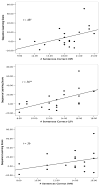Neurocognitive basis of implicit learning of sequential structure and its relation to language processing
- PMID: 19076393
- PMCID: PMC2605665
- DOI: 10.1196/annals.1416.009
Neurocognitive basis of implicit learning of sequential structure and its relation to language processing
Abstract
The ability to learn and exploit environmental regularities is important for many aspects of skill learning, of which language may be a prime example. Much of such learning proceeds in an implicit fashion, that is, it occurs unintentionally and automatically and results in knowledge that is difficult to verbalize explicitly. An important research goal is to ascertain the underlying neurocognitive mechanisms of implicit learning abilities and understand its contribution to perception, language, and cognition more generally. In this article, we review recent work that investigates the extent to which implicit learning of sequential structure is mediated by stimulus-specific versus domain-general learning mechanisms. Although much of previous implicit learning research has emphasized its domain-general aspect, here we highlight behavioral work suggesting a modality-specific locus. Even so, our data also reveal that individual variability in implicit sequence learning skill correlates with performance on a task requiring sensitivity to the sequential context of spoken language, suggesting that implicit sequence learning to some extent is domain-general. Taking into consideration this behavioral work, in conjunction with recent imaging studies, we argue that implicit sequence learning and language processing are both complex, dynamic processes that partially share the same underlying neurocognitive mechanisms, specifically those that rely on the encoding and representation of phonological sequences.
Figures







Similar articles
-
Contribution of implicit sequence learning to spoken language processing: some preliminary findings with hearing adults.J Deaf Stud Deaf Educ. 2007 Summer;12(3):317-34. doi: 10.1093/deafed/enm019. Epub 2007 Jun 4. J Deaf Stud Deaf Educ. 2007. PMID: 17548805 Free PMC article.
-
Incidental learning and social-communicative abilities in children with developmental language disorder: Further evaluating the implicit learning deficit hypothesis.Int J Lang Commun Disord. 2025 Mar-Apr;60(2):e70017. doi: 10.1111/1460-6984.70017. Int J Lang Commun Disord. 2025. PMID: 39977834 Free PMC article.
-
Implicit learning as an ability.Cognition. 2010 Sep;116(3):321-40. doi: 10.1016/j.cognition.2010.05.011. Epub 2010 Jun 22. Cognition. 2010. PMID: 20573341
-
The Role of Statistical Learning in Understanding and Treating Spoken Language Outcomes in Deaf Children With Cochlear Implants.Lang Speech Hear Serv Sch. 2018 Aug 14;49(3S):723-739. doi: 10.1044/2018_LSHSS-STLT1-17-0138. Lang Speech Hear Serv Sch. 2018. PMID: 30120449 Free PMC article. Review.
-
Towards an explicit account of implicit learning.Curr Opin Neurol. 2005 Aug;18(4):435-41. doi: 10.1097/01.wco.0000171951.82995.c4. Curr Opin Neurol. 2005. PMID: 16003121 Review.
Cited by
-
Complex response inhibition and cognitive flexibility in school-aged Cypriot-Greek-speaking children who stutter.Front Psychol. 2022 Nov 18;13:991138. doi: 10.3389/fpsyg.2022.991138. eCollection 2022. Front Psychol. 2022. PMID: 36467248 Free PMC article.
-
Reinforcement learning in young adults with developmental language impairment.Brain Lang. 2012 Dec;123(3):154-63. doi: 10.1016/j.bandl.2012.07.009. Epub 2012 Aug 24. Brain Lang. 2012. PMID: 22921956 Free PMC article.
-
Incidental auditory category learning and visuomotor sequence learning do not compete for cognitive resources.Atten Percept Psychophys. 2023 Feb;85(2):452-462. doi: 10.3758/s13414-022-02616-x. Epub 2022 Dec 12. Atten Percept Psychophys. 2023. PMID: 36510102
-
REHABILITATING LANGUAGE DISORDERS BY IMPROVING SEQUENTIAL PROCESSING: A REVIEW.J Macrotrends Health Med. 2013;1(1):41-57. J Macrotrends Health Med. 2013. PMID: 31157288 Free PMC article.
-
Age group differences in learning-related activity reflect task stage, not learning stage.Behav Brain Res. 2022 Jan 7;416:113570. doi: 10.1016/j.bbr.2021.113570. Epub 2021 Sep 7. Behav Brain Res. 2022. PMID: 34499941 Free PMC article.
References
-
- Altmann GTM, Dienes Z, Goode A. Modality independence of implicitly learned grammatical knowledge. Journal of Experimental Psychology: Learning, Memory, & Cognition. 1995;21:899–912.
-
- Baddeley AD. Working memory and language: An overview. Journal of Communication Disorders. 2003;36:189–208. - PubMed
-
- Baddeley AD. Working memory. Oxford, UK: Oxford University Press; 1986.
-
- Bapi RS, Pammi VSC, Miyapuram KP, Ahmed Investigation of sequence processing: A cognitive and computational neuroscience perspective. Current Science. 2005;89:1690–1698.
-
- Barrett HC, Kurzban R. Modularity in cognition: Framing the debate. Psychological Review. 2006;113:628–647. - PubMed
Publication types
MeSH terms
Grants and funding
LinkOut - more resources
Full Text Sources

